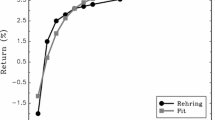Abstract
The Markowitz theory (Markowitz, 1952) is the standard framework considered in the asset management industry, and the literature has already evaluated the usefulness of these approaches for the real estate industry. Due to the lack of normality of returns, the mean-variance approach used in the Modern Portfolio theory does not work properly in the real estate industry (Cheng and Liang, 2009), and optimal portfolios constructed on the mean-variance framework frequently are suboptimal with respect to other solutions available (Byrne and Lee, 1997).
Access this chapter
Tax calculation will be finalised at checkout
Purchases are for personal use only
Preview
Unable to display preview. Download preview PDF.
Similar content being viewed by others
References
V. Agarwal and N.Y. Naik (2004) ‘Risk and Portfolio Decisions Involving Hedge Funds’, Review of Financial Studies, 17, 63–98.
G. Burke (1994) ‘A Sharper Sharpe Ratio’, Futures, 23, 56.
P. Byrne and S. Lee (1997) ‘Real Estate Portfolio Analysis under Conditions of Non-Normality: The Case of NCREIF’, Journal of Real Estate Portfolio Management, 3, 37–46.
A. Carretta and G. Mattarocci (2013) ‘Choice of Risk Measure in Evaluating UCITS Funds of Hedge Funds’ in G. Gregoriou (ed.), Reconsidering Funds of Hedge Funds. The Financial Crisis and Best Practices in UCITS, Tail Risk, Performance, and Due Diligence (San Diego: Elsevier).
P. Cheng and Y. Liang (2009) ‘Optimal Diversification: Is It Really Worthwhile?’, Journal of Real Estate Portfolio Management, 6, 7–15.
K. Dowd (2000) ‘Adjusting for Risk: An Improved Sharpe Ratio’, International Review of Economics and Finance, 9, 209–22.
M. Eling (2008) ‘Does the Measure Matter in the Mutual Fund Industry?’, Financial Analysts Journal, 64, 54–66.
M. Eling and F. Schuhmacher (2007) ‘Does the Choice of Performance Measure Influence the Evaluation of Hedge Funds?’, Journal of Banking and Finance, 31, 2632–47.
D.M. Geltner (1991) ‘Smoothing in Appraisal-Based Returns’, Journal of Real Estate Finance and Economics, 4, 327–45.
C. Giannotti and G. Mattarocci (2008) ‘Risk Diversification in a Real Estate Portfolio: Evidence from the Italian Market’, Journal of European Real Estate Research, 1, 214–34.
C. Giannotti and G. Mattarocci (2013) ‘Risk Measurement Choice in Selecting REITs: Evidence from the U.S. Market’, Journal of Real Estate Portfolio Management, 19, 137–53.
G.N. Gregoriou and J.P. Gueyie (2003) ‘Risk-adjusted Performance of Funds of Hedge Funds using a Modified Sharpe Ratio’, Journal of Wealth Management, 6, 77–83.
A. Guizot (2007) The Hedge Fund Compliance and Risk Management Guide (Chichester: Wiley).
P.D. Kaplan and J.A. Knowles (2004) ‘Kappa: A Generalized Down-side Risk-adjusted Performance Measure’, Journal of Performance Measurement, 8, 42–54.
H. Kazemi, T. Schneeweis and B. Gupta (2004) ‘Omega as a Performance Measure’, Journal of Performance Measurement, 8, 16–25.
L.N. Kestner (1996) ‘Getting a Handle on True Performance’, Futures, 25, 44–6.
S. Lee and S. Stevenson (2005) ‘Real Estate Portfolio Construction and Estimation Risk’, Journal of Property Investment & Finance, 23, 234–53.
C.H. Liu, T.V. Grissom and T.J. Hartzell (1990) ‘The Impact of Market Imperfections on Real Estate Returns and Optimal Investor Portfolios’, AREUEA Journal, 18, 453–78.
C. Lizieri and C. Ward (2000) ‘Commercial Real Estate Return Distributions: A Review of Literature and Empirical Evidence’ in J. Knight and S. Satchell (eds), Return Distributions in Finance (Oxford: Butterworths-Heinemann).
M.A. Louargand (1992) ‘A Survey of Pension Fund Real Estate Portfolio Risk Management Practices’, Journal of Real Estate Research, 7, 361–73.
H. Markowitz (1952) ‘Portfolio Selection’, Journal of Finance, 7, 77–91.
G. Mattarocci and G. Siligardos (2013) ‘Real Estate Trends and Portfolio Rebalancing: Evidence from Main European Markets’ in A. Carretta and G. Mattarocci (eds), Asset Pricing, Real Estate and Public Finance over the Crisis (Houndmills: Palgrave MacMillan).
M. Miles and T. Mocue (1984) ‘Diversification in The Real Estate Portfolio’, Journal of Financial Research, 7, 57–69.
F.C.N. Myer and J.R. Webb (1991) ‘Estimating Allocations for Mixed-asset Portfolios Using the Bootstrap Technique’, www.aresnet.org, date accessed 01 March 2015.
J.L. Pagliari, J.R. Webb and J.J. Del Casino (1995) ‘Applying MPT to Institutional Real Estate Portfolios: the Good, the Bad and the Uncertain’, Journal of Real Estate Portfolio Management, 1, 67–88.
C.S. Pedersen and T. Rudholm-Alfvin (2003) ‘Selecting a Risk-adjusted Shareholder Performance Measure’, Journal of Asset Management, 4, 152–72.
W. Shadwick and C. Keating (2002) ‘A Universal Performance Measure’, Journal of Performance Measurement, 6, 59–84.
W.F. Sharpe (1994) ‘The Sharpe Ratio’, Journal of Portfolio Management, 21, 49–58.
F.A. Sortino and H.J. Forsey (1996) ‘On the Use and Misuse of Downside Risk’, Journal of Portfolio Management, 22, 35–42.
M.S. Young (2008) ‘Revisiting Non-normal Real Estate Return Distributions by Property Type in the U.S.’, Journal of Real Estate Finance & Economics, 36, 233–48.
M.S. Young and R.A. Graff (1995) ‘Real Estate Is Not Normal: A Fresh Look at Real Estate Return Distributions’, Journal of Real Estate Finance & Economics, 10, 225–59.
M.S. Young, S.L. Lee and S.P. Devaney (2006) ‘Non-normal Real Estate Return Distributions by Property Type in the U.K.’, Journal of Property Research, 23, 109–33.
T. Young (1991) ‘Calmar Ratio: A Smoother Tool’, Futures, 20, 40.
Editor information
Editors and Affiliations
Copyright information
© 2015 Gianluca Mattarocci
About this chapter
Cite this chapter
Mattarocci, G. (2015). Optimal Asset Allocation for European Real Estate. In: Mattarocci, G., Pekdemir, D. (eds) European Real Estate. Palgrave Macmillan, London. https://doi.org/10.1057/9781137436122_9
Download citation
DOI: https://doi.org/10.1057/9781137436122_9
Publisher Name: Palgrave Macmillan, London
Print ISBN: 978-1-349-56026-4
Online ISBN: 978-1-137-43612-2
eBook Packages: Palgrave Economics & Finance CollectionEconomics and Finance (R0)




